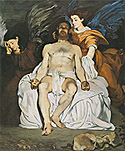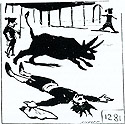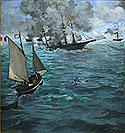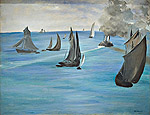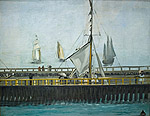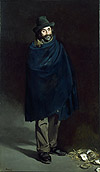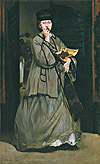The browser will either open the file, download it, or display a dialog.
|
|
Manet's Oceanic Feeling |
|||||
| I find unenclosed water intolerable. I like to see it imprisoned in a yoke between the geometrical walls of a quay. —Charles Baudelaire |
||||||
| Following a new mandate after the effect of negative chic and the general uproar over the Salon des Refusés, the jury for the Salon of 1864 had been more inclusive, and Manet exhibited two works: the Dead Christ with Angels (fig. 1) and the Episode from a Bullfight.1 The Episode was later cut up and is now known in two fragments: the Frick Collection Bullfight (fig. 2) and the Dead Toreador (fig. 3) in the National Gallery in Washington.2 The experimental perspective of the piece was succinctly captured in a caricature by Cham (fig. 4).3 Critics were often unkind to Manet, but 1864 was an early low point. "The Spanish pictures of M. Manet don't attract attention; they take it by force," said Adrien Paul in the Republican daily, Le Siècle. "One feels held up as in a corner of a woods, and mugged."4 Louis Auvray in La Revue artistique et littéraire advised Manet to study—of all people—the Barbizon landscapist Charles Jacque. "He doesn't have this mania for simplifying nature to give it more grandeur, as does M. Manet; he finds nature as it is, great enough, beautiful enough, and he copies it religiously . . . We believe, M. Manet, that which God has made is well-made, and you should content yourself with that."5 Alphonse Audéoud in La Revue indépendante also based his critique of Manet on the idea of Manet's realism, wagering that the painter's realism was not a Balzacian realism but "an exclusive cult of the ugly grotesque."6 And the pseudonymous "X, a retired painter" (actually Aubry-Foucault), in the Legitimist Gazette de France, after having compared Manet's palette to an ashtray, found the bullring to be "une masse informe" (a shapeless mass) "that holds at the same time a bull, a rhinoceros, and a rat from the sewers of Paris." Like the more well-known critique of Théophile Thoré in the same year, "X" accused Manet of imitating Goya, "that strange master who, with a few streaks of black against white, sometimes awakens, in a flash, something like the frisson of the infinite."7 After proclaiming that no one could imitate Goya and that it was a dangerous precedent for young artists to try, "X" put his money on Gustave Moreau for the future.8 | ||||||
| "X" was not the only critic who thought Moreau walked away with the Salon of 1864. Adrien Paul said the Oedipus and the Sphinx (fig. 5) was "magisterially painted and grandly conceived."9 Mme de Sault focused an entire article in the liberal daily Le Temps on Moreau's painting, and at the end, counseled young artists to follow Moreau, not Manet. "Father forgive them, for they know not what they do."10 | ||||||
| Manet left Paris for Boulogne in July following the Salon. Although his family had traveled to Boulogne before, the 1864 trip would be the first that followed the opening of the new beach club at Boulogne, as Juliet Wilson-Bareau and David Degener have shown in Manet and the Sea, an exhibition that encourages a reevaluation of Manet's seascapes.11 Manet would go on to paint the Metropolitan Museum canvas of the USS Kearsarge and a fishing boat, a watercolor of the same U.S. ship (Musée des Beaux-Arts, Dijon), and the magisterial and politically juicy Philadelphia painting of the battle between the USS Kearsarge and the Confederate ship Alabama (fig. 6).12 These paintings are rooted in Manet's familiarity with ships that dates back to his naval voyage to Rio in 1848–49, and they speak to his ongoing political interest in the New World that probably had its beginnings then and would be even more strongly realized in the series of paintings and prints he did in 1867 on the subject of the execution of Maximilian. In addition to these closely related marine works, Manet also painted Steamboat Leaving Boulogne, now in the Art Institute of Chicago (fig. 7). The wake of this steamboat cutting a slice across the glossy surface of the Channel underlines the expansiveness of the sea here: sailboats and schooners become mere shapes against the flat background of water. | ||||||
| In comparison with the ambition of The Battle of the USS "Kearsarge" and the CSS "Alabama", and certainly in comparison with the works that took a beating at the Salon, the Chicago painting is something of a day off, a whiff of fresh air. It was almost certainly executed quite rapidly. It was a chance for Manet to work in his most self-assured, painterly mode: to lay on a sensuous, nuanced blue field of water, float a few silhouettes of sailboats over it, and paint in some gray and white steam coming from the steamship. We can almost sense his delight at tracing that line of the steamboat's wake in paint; it is pure Manet. Although one can picture an emerging artist—Monet perhaps, or Whistler—painting something of equal simplicity, or finding inspiration in Japanese sources as Manet does here, no one Manet knew in 1864 would have taken on a marine subject in this manner. One can almost picture Manet in Boulogne that summer thinking to himself, "Take that, Adrien Paul! Who else can paint this way?" I think we can go even farther in our speculation as to the rejuvenating effect of the 1864 marine subjects in Manet's art. In these paintings, there is a spatial openness combined with an interest in the mobility of the subject that is entirely different, almost the antithesis of Manet's extremely costumed and studio-bound figure paintings of the early 1860s.13 In place of the paintings that represented one figure posing as another, or paintings that purported to be or to transform the image of a Parisian type, here was painting that engaged a subject that moved freely. | ||||||
| We can think back to the Episode from a Bullfight and its utter daring with regard to perspective—and maybe to the critic in Le Hanneton who looked at the painting and exclaimed "O perspective! Voilà de tes coups?" (O perspective! Take these blows!)14 The perspective could be described as that of a radically wide-angle lens that had swallowed the bull in the middle-ground, made the toreros in the background tiny, and thrust the elegant dead toreador into the foreground, right under our noses.15 By contrast, the Channel in the Chicago painting allows Manet to make seamlessly the shifts in scale from the grand sailboat in the foreground to the steamboat in the middle distance, to the flecks of gray against the horizon line—done in an instant—that represent a faraway sailboat. I would like to suggest that this is not mere casualness on Manet's part, but a crucial discovery for him, and that the repercussions for his art will be wide-ranging and significant. | ||||||
|
One notes a sense of the expansiveness of the water in many of Manet's later marine paintings. For instance, Study of Ships, Sunset of 1868, now in the Musée Malraux in Le Havre (fig. 8), shows no human figures. Unlike some of the more ambitious paintings, such as The "Kearsarge" and the "Alabama," it does not even show the interaction of ships or the presence of built elements such as a jetty. The painting is almost Whistlerian in its abstraction.16 Its format goes beyond that of the double-square—its width is more than twice its height—and its subdued grays and green-blues are heightened by a cadmium red mixed into a great deal of white, probably with a breath of burnt umber to produce the passage of flesh tone in the sky. As minimalist as this seascape by Manet is, it is not alone in his oeuvre—consider The Bay of Arcachon and Lighthouse on Cape Ferret of 1871 (Collection Rudolf Staechelin), in which a couple of fishing boats and a ghostly lighthouse against the horizon are the only signs of human presence. Or consider the pages from Manet's 1868 Boulogne sketchbook, on view at the "Manet and the Sea" exhibition after only recently coming to light. In some of these sketches, even determining the line where ocean meets sky is difficult. The aesthetic pleasure of the look of watercolor on paper is offset by what, for a nineteenth-century viewer, would have been a vertiginous, almost subjectless abstraction.17 | |||||
|
There were nineteenth-century viewers who tried to articulate this experience of limitlessness. What had been postulated by Edmond Burke in aesthetics and Immanuel Kant in philosophy as the experience of the sublime was being adapted by the disciples of Victor Cousin in the nascent discipline of psychology.18 As the Abbé Blampignon noted in the newspaper Le Correspondant in 1866:
The writer here is actually reviewing a book, Du Plaisir et de la Douleur, (Of Pleasure and Pain) , by Francisque Bouillier (1813–1899), published in 1865. Bouillier wanted the field of psychology to avoid confusing affective phenomena, such as the experience of pleasure and pain, with the expression of voluntary acts or facts.20 Before Freud theorized about the pleasure principle and the reality principle, Bouillier located the stimulus of our activity in the world in the attraction of pleasure and the avoidance of pain. Yet he went beyond this postulate as well. The pleasure that we feel in having our desires satisfied shows that desire ultimately is a function of will. Why is inactivity, or rest, also pleasurable, he wondered. The answer he proposed was that pleasure was ultimately not merely experienced passively as an affective phenomenon. We take pleasure, says Bouillier, in free activity—in the exercise of our free will. The possibility of experiencing pleasure in an unimpeded arena is the experience of looking out at ocean or desert that Blampignon describes. |
||||||
|
It is interesting that a book concerned with human desires satisfied, and pleasure taken, in the experience of unimpeded free will, would suggest to at least one writer in Le Correspondant an image of limitlessness, a feeling one gets looking out at the immensity of an expanse of ocean or sand. It is a sensation Romain Rolland, and then more famously Freud, would call the "oceanic feeling"—"a sensation of 'eternity', a feeling as of something limitless, unbounded—as it were, 'oceanic'," wrote Freud.21 Rolland had suggested that a confrontation with this feeling could be seen as the true source of religious feeling. But Freud, who could not confirm the existence of the "oceanic feeling" in himself, postulated that an infant cannot yet distinguish his own ego from the external world, and only with maturity does a person draw a boundary around an internal feeling of "self" or "ego" and a larger sensation of what is external to the self.
Might we say that the crossing of this demarcation from an experience of ego into that "primary ego-feeling" in which we no longer feel a boundary separating us from the external world, in which we can experience limitlessness, can be said to characterize a state of liminality? Manet, after all, not only gave us marine paintings approaching abstraction, like the Le Havre painting and the Boulogne sketchbook pages, but also paintings that suggest limitlessness by juxtaposing it with its opposite. Jetty at Boulogne, recently acquired by the Van Gogh Museum in Amsterdam, contrasts typically Manet-esque clusters of well-dressed spectators firmly planted, parasols and binoculars in hand, on a well-constructed horizontal form of the jetty, with a view toward the endlessness of the sea (fig. 9). The possibility of merely experiencing the social interchange on the jetty coexists with that of looking out to the horizon, toward the "vast expanse," "the immensity of the water." The painting's spectator, like the small figures contained therein, is positioned to experience one or the other; the space of the viewer is the liminal space of the jetty, glimpsing the well-defined sociability of the elegant subscribers to Boulogne's beach club, or the confrontation with the ineffable, the limitless—the very image of free activity without constraint. |
|||||
| Let me briefly recap the texts I have just intertwined. Bouillier's Du Plaisir et de la douleur located pleasure in the experience of unimpeded free will; Blampignon, in his review, found that pleasure was always more intense in the imagination, in the anticipation of it, in desire—in other words, than it was in its realization. Freud contrasts the idyllic feeling of limitlessness with the mature person's assertion of ego and firm boundaries around self and other. Identity, we might say, is formed from that insertion of boundaries: this is self—this is what remains constant about the self—this is other. An awareness of desire simply reinforces those boundaries: I am, I desire. By taking the self across that boundary to an idyllic state, pleasure transports, multiplies, and ultimately blurs the sensation of self and ego.23 That act of blurring pushes through from mundane awareness of self to the liminal state that is not stamped out by identity. I suggest that this is precisely what Manet found in the sea: a subject whose expansiveness moved him to a wholly different notion of identity, and I would like to trace how this might have unfolded after Manet's 1864 Boulogne trip. | ||||||
| First, Manet discovers the freedoms possible when representing the sea in the 1864 paintings. If the Art Institute of Chicago painting allows him to treat the ships blandly, indifferently—to use Bataille's word—as so many chess pieces on the chessboard of the glossy sea, the "Kearsarge" and the "Alabama" was the reverse: the ships are filled with sailors, the sea is a battlefield, the United States in the Kearsarge firing at, fatally wounding the South, its interests, and Napoleon III's support for the secession.24 Manet's new spatial arena, we might say, could embrace either fairly neutral subjects or highly charged ones. He returns to Paris and prepares for the Salon of 1865. That history is well-known. He feels overwhelmed and defeated by the critiques of Olympia (Musée d'Orsay, Paris) and the Christ Mocked by the Soldiers (Art Institute of Chicago), complains to Baudelaire and leaves for Madrid. After seeing Velázquez in the Prado, he paints the suite of philosopher-beggars (fig. 10).25 | ||||||
| Consider the space in the Philosopher. It is true that it was not the first Manet figure painting with an apparently blank background; Manet had tried this at least as early as 1862 in his Boy with a Sword (Metropolitan Museum of Art, New York). The so-called blank background, however, takes on a different feel as Manet rethinks the large-scale figure painting through Velázquez and through the sea paintings of 1864. The background in the Philosopher is not a simple absence; it is palpable; it is felt; it holds its own next to the figure. It creates an atmosphere not unlike that of the fog eclipsing the horizon line beyond the jetty in the Van Gogh Museum picture. It is "oceanic." And its effects on the way we read the figure in the painting are oceanic as well. If Manet in the early 1860s frequently depicted marginal figures in Paris, such as The Old Musician (National Gallery of Art, Washington) and The Street Singer (fig. 11), those figures were usually represented in a context. However vague the trees and rocks in The Old Musician are, they are definitive enough that Marilyn Brown, as well as Theodore Reff, can relate the painting to the neighborhood of La Petite Pologne.26 The Street Singer is coming out of an estaminet (inn) in which we can see hats hanging on a wall, customers, an aproned waiter, and potted plants. Our reading of the singer as nomadic and elusive is facilitated by her coming out of that context of cafés and the repression of public begging in the 1860s.27 These paintings have been understood, mostly rightly I believe, as rooted in nineteenth-century materialism: human subjects—their appearance, character, gestures, manners—ultimately derive from the material context in which they can be found. Yet there has always been something in Manet's figure paintings that goes beyond this classical conception, this narrative that out of a given material context comes a predictable, accountable set of characteristics.28 It is hinted at in the way Victorine Meurent appears alternately as courtesan, street singer, and bullfighter, but it comes to fruition in the figure paintings of 1865 and after: works in which we are given no clear material context in which to situate the figure that stands before us. | ||||||
| Formalism has always had a good argument when it came to these figure paintings. Manet's Fifer (Musée d'Orsay, Paris) issues from the challenge of Velázquez and says to the world that the painter can construct an illusion of convexity with the most minimal of means. Manet can make épaulettes and stripes that almost, but not quite, line up with the contours of the figure; give him the tiniest of shadows; make him stand against a background without any articulation whatsoever, and make him take form. Manet, says the formalist, puts a carafe and a lemon next to Théodore Duret because the painting needs that extra burst of color.29 But how can these arguments suffice when the subject is an impoverished beggar holding out his hand? How does the historian balance political concerns and formal concerns when it comes to a subject that cannot be accounted for in form and color alone? | ||||||
|
The answer, I think, is in the "oceanic." If Manet creates a ground for these figures that is absolute, blanketing, suggestive of a space that is infinite but giving us no coordinates by which to take its measure—not even a figure with binoculars on a jetty—Manet is perhaps looking for the sensation of the expansiveness of the ocean, and (perhaps) doing so specifically in order to represent a figure whose "gestures, attitudes, ways of envisaging the world, and behavior" "come first."30 Here, I quote from Bernard-Henri Lévy on Sartre because I think the way Manet stages the viewer's confrontation with the beggar-philosopher prefigures Sartre's existentialism. It is a view of the human subject rooted in materialism, and still looking for ways of pushing that materialism to new limits. It is a way of remaining faithful to materialism while positing human freedom at the same time. |
||||||
|
The new visual thinking that comes out of Manet's 1864 Boulogne trip also extends to more complex, multifigure subjects. Consider, for instance, the picture in the Art Institute of Chicago that has been called Races at Longchamp and generally assigned to 1867 (fig. 12).31 Prior to undertaking this painting, Manet had painted a watercolor, now in the Harvard University Art Museums, with a panoramic view of the racetrack from the stands at right to the elite party waiting past the finish line on the left side of the composition (fig. 13). The Chicago painting was actually cut from a larger canvas that originally resembled the 1864 watercolor composition more closely. The result of the cropping is a complete revision in the space of the oil painting that is, I would argue, rooted in what Manet discovered in painting Steamboat Leaving Boulogne. The highly simplified ocean painting allowed Manet the opportunity to look out at an almost limitless expanse of water, without the constraints of urban landmarks or the special demands of models and historical subjects, and literally move the compositional elements—the few simple shapes of boats—around freely. This directly affects the formulation of the space in the Races at Longchamp. There, it is as if the flat plane of the sea with its ships moving away from us has been inverted, and the artist funnels the space toward us instead. Ships sailing away have become horses thundering toward the viewer. The cutting of the painting has emphasized this through the removal of the panorama of elite spectators at left, and through the placement of the group of horses even closer to the painting's foreground. Manet intensifies the sensation of space in the painting by concentrating the energy in it.32 The unleashing of the horses, I would suggest, can be seen as a development of what he experiences in painting the sea at Boulogne. |
||||||
| This essay has emphasized a notion of the "oceanic" with roots in Romanticism and the aesthetic of the sublime. It is important to remember, however, that many nineteenth-century viewers were sufficiently briefed as to the dangers and terrors of the sea that the way in which they experienced the ocean was as protected as possible. As Alain Corbin has shown, upper-class women and tourists were specifically instructed as to ways in which the waters should be taken, which included the wearing of flannel smocks, clogs or ankle boots for walking on sand, the dumping of buckets of water over the head to prepare oneself for immersion, and the retreat into the privacy and comfort of the bathing machine, invented in Boulogne: a Bath chair built up into a mobile cabin pulled by a horse (fig. 14).33 We even see one in Manet's 1868 Beach at Boulogne (fig. 15). The bathing machine and its rituals suggest that at least for the upper-class nineteenth-century urban-dweller, the experience of the water was the experience of a frisson, and the idea was to control that, to protect people from it, maybe even to keep people from having an oceanic feeling. | ||||||
| For Manet, the sea was more than merely the antithesis of the social scene in Paris. It opened up a new way of thinking for him. How does one paint the sea in its materiality? Courbet had asked that question, and answered it; Manet looks at the sea in its materiality and discovers its unknowability, maybe even what the painter-critic "X" meant by that "frisson de l'infini." He rediscovers a different kind of space—we could even call it the space of painting. | ||||||
|
This essay is a revised version of a paper presented at the symposium "Manet: Eternal Modern" at the Philadelphia Museum of Art on April 19, 2004, held in conjunction with the museum's installation of the exhibition Manet and the Sea; I would like to thank John Zarobell and Joe Rishel for that opportunity. I would also like to acknowledge comments made at the symposium by Juliet Wilson-Bareau and Steven Z. Levine that I have incorporated here, as well as comments by my colleagues Charlotte Houghton, Sarah Rich, and Brian Curran. Furthermore, I would like to thank the anonymous reviewer for Nineteenth-Century Art Worldwide, Robert Alvin Adler for his editorial suggestions, Lucy Locke for help with translations, and most of all, Christopher Campbell for sharing his insights into Manet's paintings in ways that guided my analysis here. 1. On the Salon jury, see Adolphe Tabarant, Manet et ses oeuvres, 6th ed. (Paris: Librairie Gallimard, 1947), pp. 81–2. 2. Summarized in Françoise Cachin, Charles S. Moffett, and Michel Melot, Manet 1832–1883, Exh. cat. (New York: Metropolitan Museum of Art and Harry N. Abrams, 1983), pp. 195–98. 3. On the reconstruction of the painting, see Susan Grace Galassi et al., Manet's "The Dead Toreador" and "The Bullfight": Fragments of a Lost Salon Painting Reunited, Exh. cat. (New York: Frick Collection, 1999). The Cham appeared in Le Charivari, 22 May 1864. 4. Adrien Paul, "Salon de 1864," Le Siècle, 29 May 1864: "Les toiles espagnoles de M. Manet n'attirent pas l'attention, elles la prennent de force; on se sent arrêté comme au coin d'un bois, et l'on s'en revient dévalisé." Unless otherwise noted, all translations in the text are my own. 5. Louis Auvray, "Salon de 1864," La Revue artistique et littéraire, 5 année, t. 7 (1864): pp. 14–15: "M. Charles-Émile Jacque, peint les animaux et le paysage avec un talent supérieur. Voilà un interprète fidèle de la vie des champs, il n'a pas, comme M. Manet, la manie de simplifier la nature pour lui donner plus de grandeur, il trouve la nature, telle qu'elle est, assez grande, assez belle, et il la copie religieusement . . . Ah! M. Manet, venez méditer devant le tableau de M. Jacque, et vous reconnaîtrez que la vraie nature est celle que cet artiste a peinte, celle que tout le monde voit, et non celle qu'une imagination égarée veut inventer. Croyons-nous, M. Manet, ce que Dieu a fait est bien fait, contentez-vous en." 6. Audéoud, La Revue indépendante, 1 July 1864, p. 768. Manet is allied with Fantin-Latour and Courbet along these lines. In that same journal, the same reviewer would go on to write at the Salon of 1865: "D'autres [artistes] encore prétendent forcer l'admiration en exagérant la réalité, ou plutôt en cultivant le laid, le grotesque et l'horrible" (15 June 1865), p. 720. 7. "X," [Aubry-Foucault], "Le Salon de 1864," Gazette de France, 11 June 1864: "ce maître étrange qui, avec quelques rayures de noir sur du blanc, éveille parfois, dans un éclair, comme le frisson de l'infini." On Thoré's critique, see Tabarant, Manet et ses oeuvres, 1947, p. 85. 8. Ibid. 9. Paul, "Salon de 1864": "magistralement peinte et grandement conçue." For an interesting discussion of the success of Moreau's painting and the perceptibly negative critical effect it had on Manet's paintings in Room "M," see Michael Fried, Manet's Modernism, or, The Face of Painting in the 1860s (Chicago: University of Chicago Press, 1996), pp. 308–17. 10. C. de Sault [Mme de Charnace], "Salon de 1864," Le Temps 12 May 1864; see also Tabarant, Manet et ses œuvres, 1947, p. 83. 11. Juliet Wilson-Bareau and David Degener et al., Manet and the Sea, Exh. cat. Art Institute of Chicago, Philadelphia Museum of Art, and Van Gogh Museum, Amsterdam (Philadelphia: Philadelphia Museum of Art, 2003), p. 63. 12. The full titles are: USS "Kearsarge" off Boulogne—Fishing Boat Coming In Before the Wind (Metropolitan Museum of Art), USS "Kearsarge" off Boulogne (Musée des Beaux-Arts, Dijon), and The Battle of the USS "Kearsarge" and the CSS "Alabama" (Philadelphia Museum of Art). 13. This aspect of Manet's art has received special emphasis in Carol Armstrong, "To Paint, to Point, to Pose: Manet's 'Le Déjeuner sur l'herbe'," in Paul H. Tucker, ed. Manet's "Le Déjeuner sur l'herbe" (New York: Cambridge University Press, 1998), pp. 90–118. 14. Spitafangama, "Au Salon," Le Hanneton: Journal des Toqués (26 June 1864), p. 4. The critic mistakenly refers to Manet as Massé. 15. Anne Coffin Hanson compares compositional strategies among the lost Episode, the Mlle V. in the Costume of an Espada (Metropolitan Museum of Art, New York), and the seascapes of 1864 (especially the Philadelphia Kearsarge) in "A Group of Marine Paintings by Manet," Art Bulletin 44, no. 4 (December 1962), pp. 332–33. 16. Manet, of course, knew Whistler, and both appear in Fantin-Latour's Hommage à Delacroix of 1864 (Musée d'Orsay, Paris). 17. It is interesting to contemplate Baudelaire's comments on the pastel seascapes of Boudin that he recounted seeing in the artist's studio in his "Salon of 1859," and Manet's possible recollection of them when he undertook these paintings. Although Baudelaire claims not to miss the human figures absent from the seascapes, he also maintains that they are studies that will need to be developed into paintings. See Oeuvres complètes, ed. Marcel A. Ruff (Paris: Aux Éditions du Seuil, 1968), p. 417. 18. For a penetrating discussion of the aesthetic of the sublime as it relates to Monet's seascapes, see Steven Z. Levine, "Seascapes of the Sublime: Vernet, Monet, and the Oceanic Feeling," New Literary History 16, no. 2 (Winter 1985), pp. 377–400. 19. E. A. [Émile Antoine] Blampignon, review of Francisque Bouillier, Du Plaisir et de la douleur, in Le Correspondant (25 November 1866), p. 758: "En presence d'une vaste étendue, de l'immensité des sables ou des eaux, de l'Océan ou du Sahara, l'âme éprouve une ineffable satisfaction. C'est qu'elle y voit l'image de la liberté sans nulle barrière, de l'étendue sans aucune limite. Elle s'y croit transportée et y vole en imagination. En se sentant dégagé pour un moment de toute contrainte, l'homme est heureux, tandis qu'il s'assombrit en se trouvant si dépendant et si rétréci. . . . Le plus vif plaisir est dans l'idée qu'on s'en fait. Nous rêvons longtemps aux joies dont nous berçons notre imagination, et, le moment de la possession venu, il se trouve que nous attendions mieux. La vie se passe à désirer." 20. Francisque Bouillier, Du Plaisir et de la douleur (Paris: Baillière, 1865), p. 23. Blampignon and Bouillier were linked by their mutual interest in the Cartesian philosopher Malebranche; Blampignon had already cited Bouillier's 1854 Histoire de la philosophie cartésienne in his Étude sur Malebranche d'après des documents manuscrits, suivie d'une correspondance inédite (Paris: Charles Douniol, 1862), 100. 21. Sigmund Freud, Civilization and its Discontents, trans., ed. James Strachey (New York: W. W. Norton and Company, 1989), p. 11. 22. Ibid., p. 15. 23. Here, I am drawing on the thinking of Michel Foucault, especially as analyzed by David M. Halperin in Saint Foucault: Towards a Gay Hagiography (New York: Oxford University Press, 1995), pp. 94–96. 24. On The Battle of the U.S.S. "Kearsarge" and the C.S.S. "Alabama", see Juliet Wilson-Bareau and David C. Degener, Manet and the American Civil War: The Battle of the U.S.S. 'Kearsarge' and the C.S.S. 'Alabama', Exh. cat. Metropolitan Museum of Art, New York (New Haven: Yale University Press, 2003). Georges Bataille discusses Manet's "supreme indifference" to the subject in Manet (New York: Skira/Rizzoli, 1983), passim. 25. During the discussion period at the symposium "Manet: Eternal Modern" at the Philadelphia Museum of Art, April 19, 2004, Juliet Wilson-Bareau questioned the traditional account that the Philosopher series was painted after Manet's 1865 trip to Spain, and her catalogue entry for A Philosopher (Beggar with Oysters) in Gary Tinterow and Geneviève Lacambre, Manet/Velázquez: The French Taste for Spanish Painting, Exh. cat. Metropolitan Museum of Art, New York (New Haven: Yale University Press, 2003), p. 494, also suggests that Manet had painted them before his encounter with the work of Velázquez. In her view, the restoration of the two Chicago Philosopher paintings "clearly revealed their facture" that could be contrasted with the "more luminous aspect and freer handling of The Ragpicker" (Norton Simon Museum, Pasadena, California), dated to 1869. Although the series marks a return to the "ragpicker" subject of Manet's rejected 1859 Salon submission, the Absinthe Drinker (Ny Carlsberg Glyptotek, Copenhagen), which was certainly executed well before Manet had seen Velázquez in any depth or breadth, it is possible that the paintings owe less to Velázquez than is commonly assumed, or that some were at least begun prior to the 1865 trip. I am, however, supporting the view that the Philosopher series was largely inspired by Manet's trip to the Prado, a view which was recently upheld in the catalogue by Manuela B. Mena Marqués, Manet en el Prado, Exh. cat. (Museo Nacional del Prado, 2003), pp. 247, 462. Mena Marqués also acknowledges Wilson-Bareau's theory that the paintings could have been inspired by Goya's etched copies of Velázquez; however, she finds that the Philosophers' "size and force" suggest their indebtedness to the 1865 trip to Spain. 26. Marilyn R. Brown, "Manet's 'Old Musician': Portrait of a Gypsy and Naturalist Allegory," Studies in the History of Art 8 (1978): pp. 77–87, and Theodore Reff, Manet and Modern Paris, Exh. cat. (Washington: National Gallery of Art, 1982), pp. 174–75. 27. See my Manet and the Family Romance (Princeton: Princeton University Press, 2001), pp. 65–71. On the repression of saltimbanques (street clowns), see T. J. Clark, The Absolute Bourgeois: Artists and Politics in France, 1848–1851 (1973; Princeton: Princeton University Press, 1982), pp. 118–23. 28. My thinking here, and my use of the words "narrative" and "classical," are indebted to Bernard-Henri Lévy's account of Sartre's critique of psychologism in Sartre: Philosopher of the Twentieth Century, trans. Andrew Brown (Cambridge, UK: Polity, 2003), p. 50. 29. See the Portrait of Théodore Duret, 1868 (Musée du Petit Palais, Paris); for the sitter's account of the addition of the lemon, see Théodore Duret, Histoire d'Édouard Manet et de son oeuvre, 4th ed. (Paris: Bernheim-Jeune, 1926), pp. 88–89. 30. Lévy, Sartre: Philosopher of the Twentieth Century, 2003, p. 50. 31. In her keynote address for "Manet: Eternal Modern," delivered on 18 April 2004, Juliet Wilson-Bareau provocatively analyzed this series of paintings and related drawings as possibly having roots in Manet's 1864 Boulogne trip. Wilson-Bareau suggested that the landmarks and topography in the background bear a close similarity with the outskirts of Boulogne, and do not match the view of the Paris environs from the Longchamp racetrack in the Bois de Boulogne. If this is the case, and Races at Longchamp was actually painted or begun in Boulogne itself, then there would be additional support for my argument in the text that lessons learned from Steamboat Leaving Boulogne could have been applied to the Races painting. 32. This concentration of energy is different from Michael Fried's analysis of the passages of the painting that connote "speed of execution," although he aptly addresses the disparate modes of the painting; Fried, Manet's Modernism, 1996, pp. 221–23. 33. Alain Corbin, The Lure of the Sea: The Discovery of the Seaside in the Western World, 1750–1840, trans. Jocelyn Phelps (Berkeley: University of California Press, 1994), pp. 57–96. See also P.-J.-B. Bertrand, Précis de l'histoire physique, civile et politique, de la ville de Boulogne-sur-Mer et de ses environs, depuis les Morins jusqu'en 1814, 2 vols. (Boulogne: Tous les Libraires, 1829), vol. 2, pp. 551–54, and Wilson-Bareau and Degener, Manet and the Sea, p. 62.
|


